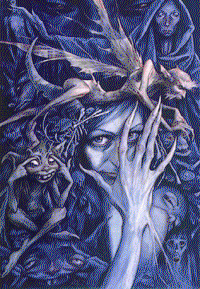(continued from last week)
3. SELFLESS ACTS -- Doing at least one selfless act a day and taking joy from it can bring the faeries into your life in surprising ways. Feed the birds, drive less, save a spider, care for a plant, stop creating so much rubbish . . . there are countless ways to embrace nature.
The first time I consciously saw faeries as an adult was late one night (and, yes, I was entirely sober), as I was making and wrapping Winter Solstice and Christmas gifts for friends. I was completely involved with the task and enjoying it when bright bits of coloured light suddenly danced around me and on the gifts. I stopped what I was doing, suddenly afraid my retinas might be detaching. Immediately, a strange, crackly voice right next to my ear said, ‘Brush your teeth.’ That made me laugh. Uncontrollably. Like, belly-ache, tears-streaming-down-the-face type laughter for at least 5 minutes. Okay, it was funny, but not that funny.
About six months later, I was travelling up to Donegal with a friend to do research for a historical novel I was writing. I met with a sweet little old lady – a retired school teacher with a near genius IQ – who spent an entire day, generously sharing historical knowledge with me. At one point, the friend I was travelling with asked the elderly lady if she’d ever seen faeries.
‘Oh they’re around,’ she said.
‘How do you know?’ my friend asked.
The woman was quiet for a moment, then she said, ‘Have ye ever had a fit of the giggles for no good reason and found it hard to stop laughing?’
‘Yeah.’
‘That’s them!’
There’s a fine line between magic and madness. Near-hysterical laughter can be a little frightening, like riding an out of control roller coaster. But if you’re willing to go for that ride, it can also be a wonderful endorphin rush.
A.G.Manning’s ‘Nature Spirit Invocation’ can prove most helpful when trying to see the folk. It is best to put out an offering of some sort first. The traditional offering is cake and ale, but just about anything will do. It is recommended that you recite this invocation at least three times, preferably outside or in a darkened room by the light of one candle. Then be still, close your eyes and notice what happens. You may feel someone playing with your hair, hear objects move or see coloured lights. Tonight is the dark of the moon, an excellent time to try this . . .
Little people everywhere,
Your fun and love I seek to share,
Gronkydoddles hear my call,
Leprechauns come one and all.
Leader, Gob, of Gnome and Troll,
Come and share your humour droll.
Neckna and your Undines, bold,
Play with me your games of old.
Paralda, Zephryrs of the air,
Caress me where my skin is bare.
Salamanders let by Djin,
The candle flames come play in.
Nature spirits of all sort
In friendship let us now cavort.
A child of love for you I’ll be,
My mood is light as you can see.
And always as you sing and play,
I feel my problems fade away.
Your laughter, love and fun come through
And help me feel alive like you.
You may well find that your offering of food does not disappear. It is said that the folk can take what nourishment they need from food without actually eating it. Then you can throw it out onto the Earth for other creatures to eat. Do not eat it yourself as this is considered bad manners; like eating food someone else already ate and spit out.
When you do see nature spirits, if you will treat them as you would any wild creature, with caution and respect, you will be gifted with sight beyond vision and true artistic inspiration.













